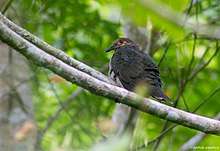Amethyst brown dove
The amethyst brown dove (Phapitreron amethystinus) is a species of bird in the family Columbidae.
| Amethyst brown dove | |
|---|---|
 | |
| Scientific classification | |
| Kingdom: | Animalia |
| Phylum: | Chordata |
| Class: | Aves |
| Order: | Columbiformes |
| Family: | Columbidae |
| Genus: | Phapitreron |
| Species: | P. amethystinus |
| Binomial name | |
| Phapitreron amethystinus Bonaparte, 1855 | |
It is endemic to the Philippines. It occurs on most large islands except Palawan but is generally rather scarce on Luzon and Mindanao and even rarer elsewhere. Its natural habitats are subtropical or tropical moist lowland forests and subtropical or tropical moist montane forests. It is found in lowlands but probably prefers middle and high elevations at 500-2000m. It is most often seen singly or in pairs, in and around fruiting trees. The call is a deep, sonorous "hoop" as well as a rather rapid "poo-poo-poo-poop", and birds may sit and call for long periods.
Description
According to Constantino (2011), the amethyst brown dove is strikingly alike with white-eared brown dove due to the presence of subocular white lines just below the eye.[2] However, it can be distinguished from the rest as they are rare deep-woods birds with colors that are generally darker brown than P. leucotis, with bills that are noticeably longer and heavier than its tarsus[3] and an extensive bluer purple patch on its mantle.[2] Some of its physical features include a grey tinge and purplish brown underparts, rich tan undertail-coverts, dark and white sub-ocular eye-lines, reddish-brown chin and throat with darker streaking, shading on breast to medium to darkish dull brown with narrowly edged dark back and scapulars.[4] They also have pink flesh around the eye with amethyst or purple iridescence on the nape.[5]
References
- BirdLife International (2012). "Phapitreron amethystinus". IUCN Red List of Threatened Species. 2012. Retrieved 26 November 2013.CS1 maint: ref=harv (link)
- Constantino, 2011
- McGregor, 1909
- Baptista et al., 2017
- P. Simpson, pers. Commun., September 11, 2017
Works cited
- Baptista, L.F., Trail, P.W., Horblit, H.M., Kirwan, G.M. and E.F.J. Garcia. 2017. Amethyst Brown-dove (Phapitreron amethystinus). In: del Hoyo, J., Elliott, A., Sargatal, J., Christie, D.A. & de Juana, E. (eds.). Handbook of the Birds of the World Alive. Lynx Edicions, Barcelona, retrieved from: http://www.hbw.com/node/54284
- Constantino, A. 2011. A calling amethyst brown-dove [HD]. Retrieved from Birding Adventure Philippines: http://www.birdingphilippines.com/2011/10/13/a-calling-amethyst-brown-dove-hd/
- McGregor, R. C. 1909. A manual of Philippine birds (Vol. 2). Ripol Classic Publishing House.
